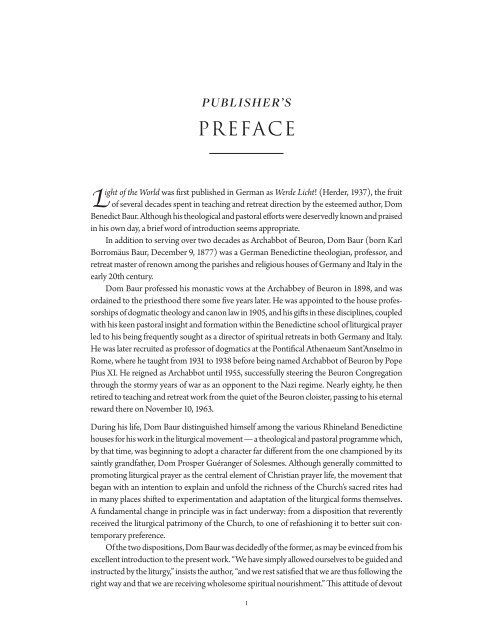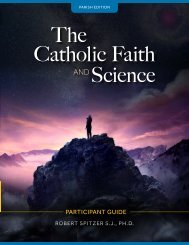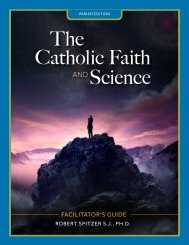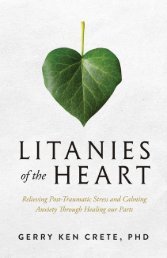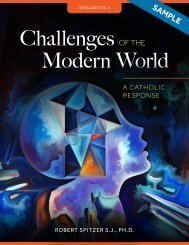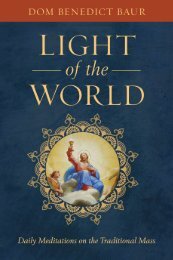- Page 3: THE LIGHT of THE WORLD i
- Page 6 and 7: BENEDICTUS BOOKS Copyright © 2022
- Page 8 and 9: PART TWO THE EASTER CYCLE INTRODUCT
- Page 12 and 13: The Light of the World receptivity
- Page 14 and 15: The Light of the World The treatmen
- Page 16 and 17: The Light of the World Like all oth
- Page 18 and 19: The Light of the World ECCE VENIT,
- Page 20 and 21: The Light of the World “To Thee I
- Page 22 and 23: The Light of the World “Prepare y
- Page 24 and 25: The Light of the World likewise the
- Page 26 and 27: The Light of the World Prayer To Th
- Page 28 and 29: The Light of the World “He shall
- Page 30 and 31: The Light of the World lives ought
- Page 32 and 33: The Light of the World our true sta
- Page 34 and 35: The Light of the World “The Lord
- Page 36 and 37: The Light of the World marvelous wo
- Page 38 and 39: The Light of the World Wednesday
- Page 40 and 41: The Light of the World me all ye th
- Page 42 and 43: The Light of the World First Day in
- Page 44 and 45: The Light of the World Prayer Deliv
- Page 46 and 47: The Light of the World “Draw us,
- Page 48 and 49: The Light of the World it recognize
- Page 50 and 51: The Light of the World St. Lucy mad
- Page 52 and 53: The Light of the World “The Lord
- Page 54 and 55: The Light of the World “The Lord
- Page 56 and 57: The Light of the World The angel of
- Page 58 and 59: The Light of the World He has given
- Page 60 and 61:
The Light of the World gives Him to
- Page 62 and 63:
The Light of the World Fourth Sunda
- Page 64 and 65:
The Light of the World At the Conse
- Page 66 and 67:
The Light of the World Prayer Drop
- Page 68 and 69:
The Light of the World Inspire us w
- Page 70 and 71:
The Light of the World Christ the K
- Page 72 and 73:
The Light of the World secret sins.
- Page 74 and 75:
The Light of the World Christ, the
- Page 76 and 77:
The Light of the World FILIUS DATUS
- Page 78 and 79:
The Light of the World she undergoe
- Page 80 and 81:
The Light of the World Vigil of Chr
- Page 82 and 83:
The Light of the World in the crib.
- Page 84 and 85:
The Light of the World Prayer Grant
- Page 86 and 87:
The Light of the World who wishes t
- Page 88 and 89:
The Light of the World December 28,
- Page 90 and 91:
The Light of the World He gave them
- Page 92 and 93:
The Light of the World She was the
- Page 94 and 95:
The Light of the World the flesh, t
- Page 96 and 97:
The Light of the World “He hath b
- Page 98 and 99:
The Light of the World us to long j
- Page 100 and 101:
The Light of the World disintereste
- Page 102 and 103:
The Light of the World The lessons
- Page 104 and 105:
The Light of the World 13:35). Chri
- Page 106 and 107:
The Light of the World GLORIA DOMIN
- Page 108 and 109:
The Light of the World found watchi
- Page 110 and 111:
The Light of the World Feast of Epi
- Page 112 and 113:
The Light of the World We rejoice w
- Page 114 and 115:
The Light of the World we can make
- Page 116 and 117:
The Light of the World Feast of the
- Page 118 and 119:
The Light of the World Our particip
- Page 120 and 121:
The Light of the World persuaded th
- Page 122 and 123:
The Light of the World Octave of Ep
- Page 124 and 125:
The Light of the World both are cha
- Page 126 and 127:
The Light of the World of God, livi
- Page 128 and 129:
The Light of the World As the royal
- Page 130 and 131:
The Light of the World God chooses
- Page 132 and 133:
The Light of the World Prayer May t
- Page 134 and 135:
The Light of the World No one can o
- Page 136 and 137:
The Light of the World “The right
- Page 138 and 139:
The Light of the World “To no men
- Page 140 and 141:
The Light of the World Thursday As
- Page 142 and 143:
The Light of the World If one is to
- Page 144 and 145:
The Light of the World Fourth Sunda
- Page 146 and 147:
The Light of the World sleep and re
- Page 148 and 149:
The Light of the World realizes tha
- Page 150 and 151:
The Light of the World Prayer O God
- Page 152 and 153:
The Light of the World dry branches
- Page 154 and 155:
The Light of the World to love the
- Page 156 and 157:
The Light of the World Meditation
- Page 158 and 159:
The Light of the World favors. He n
- Page 160 and 161:
The Light of the World Wednesday Ch
- Page 162 and 163:
The Light of the World which do not
- Page 164 and 165:
The Light of the World measure mast
- Page 166 and 167:
The Light of the World Sixth Sunday
- Page 168 and 169:
The Light of the World Would that s
- Page 170 and 171:
The Light of the World We rejoice a
- Page 172 and 173:
The Light of the World were quiet a
- Page 174 and 175:
The Light of the World we accept wi
- Page 176 and 177:
The Light of the World “The kingd
- Page 178 and 179:
The Light of the World O God, our r
- Page 180 and 181:
The Light of the World the eternal
- Page 182 and 183:
The Light of the World Prayer O God
- Page 184 and 185:
The Light of the World magnified in
- Page 186 and 187:
The Light of the World the temple o
- Page 188 and 189:
The Light of the World decisions wh
- Page 190 and 191:
The Light of the World grace; and m
- Page 192 and 193:
The Light of the World Introduction
- Page 194 and 195:
The Light of the World “The kingd
- Page 196 and 197:
The Light of the World thou hast ha
- Page 198 and 199:
The Light of the World I dare act o
- Page 200 and 201:
The Light of the World victory: res
- Page 202 and 203:
The Light of the World reject all t
- Page 204 and 205:
The Light of the World “Arise, wh
- Page 206 and 207:
The Light of the World These suffer
- Page 208 and 209:
The Light of the World Prayer O God
- Page 210 and 211:
The Light of the World “At that t
- Page 212 and 213:
The Light of the World we once reje
- Page 214 and 215:
The Light of the World (Epistle).
- Page 216 and 217:
The Light of the World Meditation S
- Page 218 and 219:
The Light of the World know in part
- Page 220 and 221:
The Light of the World “Lord, tha
- Page 222 and 223:
The Light of the World ministers of
- Page 224 and 225:
The Light of the World “By the fa
- Page 226 and 227:
The Light of the World love, the Ch
- Page 228 and 229:
The Light of the World this spirit,
- Page 230 and 231:
The Light of the World Meditation T
- Page 232 and 233:
The Light of the World His Church a
- Page 234 and 235:
The Light of the World But they mur
- Page 236 and 237:
The Light of the World membership i
- Page 238 and 239:
The Light of the World to us! Holy
- Page 240 and 241:
The Light of the World narrow gate;
- Page 242 and 243:
The Light of the World followed. Th
- Page 244 and 245:
The Light of the World self-love, a
- Page 246 and 247:
The Light of the World Prayer Grant
- Page 248 and 249:
The Light of the World and John, br
- Page 250 and 251:
The Light of the World the time for
- Page 252 and 253:
The Light of the World the passion
- Page 254 and 255:
The Light of the World return to th
- Page 256 and 257:
The Light of the World Christ, who
- Page 258 and 259:
The Light of the World confidently
- Page 260 and 261:
The Light of the World prayers and
- Page 262 and 263:
The Light of the World for Thy peop
- Page 264 and 265:
The Light of the World the Samarita
- Page 266 and 267:
The Light of the World In virtue of
- Page 268 and 269:
The Light of the World In Jerusalem
- Page 270 and 271:
The Light of the World these things
- Page 272 and 273:
The Light of the World With gratefu
- Page 274 and 275:
The Light of the World His special
- Page 276 and 277:
The Light of the World Friday Today
- Page 278 and 279:
The Light of the World entrusted us
- Page 280 and 281:
The Light of the World DEUS MEUS, R
- Page 282 and 283:
The Light of the World Meditation
- Page 284 and 285:
The Light of the World Christ nor t
- Page 286 and 287:
The Light of the World den of the t
- Page 288 and 289:
The Light of the World This is a da
- Page 290 and 291:
The Light of the World Friday Eight
- Page 292 and 293:
The Light of the World are most int
- Page 294 and 295:
The Light of the World all oppositi
- Page 296 and 297:
The Light of the World sins of His
- Page 298 and 299:
The Light of the World Monday Like
- Page 300 and 301:
The Light of the World Peter never
- Page 302 and 303:
The Light of the World Prayer O God
- Page 304 and 305:
The Light of the World and offering
- Page 306 and 307:
The Light of the World avowal of ou
- Page 308 and 309:
The Light of the World of the kingd
- Page 310 and 311:
The Light of the World March 19, St
- Page 312 and 313:
The Light of the World and with all
- Page 314 and 315:
The Light of the World humble himse
- Page 316 and 317:
The Light of the World Easter sets
- Page 318 and 319:
The Light of the World We have been
- Page 320 and 321:
The Light of the World the people a
- Page 322 and 323:
The Light of the World that Christ
- Page 324 and 325:
The Light of the World to suffer wi
- Page 326 and 327:
The Light of the World And Jesus, c
- Page 328 and 329:
The Light of the World The Epistle
- Page 330 and 331:
The Light of the World leads them t
- Page 332 and 333:
The Light of the World Our receptio
- Page 334 and 335:
The Light of the World of the state
- Page 336 and 337:
The Light of the World As newborn b
- Page 338 and 339:
The Light of the World whereby we m
- Page 340 and 341:
The Light of the World spiritual dr
- Page 342 and 343:
The Light of the World recognizes J
- Page 344 and 345:
The Light of the World consolations
- Page 346 and 347:
The Light of the World “I know My
- Page 348 and 349:
The Light of the World Thursday St.
- Page 350 and 351:
The Light of the World commands of
- Page 352 and 353:
The Light of the World Third Sunday
- Page 354 and 355:
The Light of the World little while
- Page 356 and 357:
The Light of the World Prayer Grant
- Page 358 and 359:
The Light of the World chosen by Go
- Page 360 and 361:
The Light of the World full of acti
- Page 362 and 363:
The Light of the World Saturday “
- Page 364 and 365:
The Light of the World With gratefu
- Page 366 and 367:
The Light of the World changing thi
- Page 368 and 369:
The Light of the World The doctrine
- Page 370 and 371:
The Light of the World with Him, wh
- Page 372 and 373:
The Light of the World The Holy Gho
- Page 374 and 375:
The Light of the World As our high
- Page 376 and 377:
The Light of the World (Epistle). W
- Page 378 and 379:
The Light of the World the life of
- Page 380 and 381:
The Light of the World he unites hi
- Page 382 and 383:
The Light of the World whole Church
- Page 384 and 385:
The Light of the World Since the As
- Page 386 and 387:
The Light of the World Prayer Grant
- Page 388 and 389:
The Light of the World His glorifie
- Page 390 and 391:
The Light of the World think that h
- Page 392 and 393:
The Light of the World This He does
- Page 394 and 395:
The Light of the World to the Son
- Page 396 and 397:
The Light of the World up to the le
- Page 398 and 399:
The Light of the World A submissive
- Page 400 and 401:
The Light of the World VENI, SANCTE
- Page 402 and 403:
The Light of the World Thou, of all
- Page 404 and 405:
The Light of the World Prayer O alm
- Page 406 and 407:
The Light of the World In our recep
- Page 408 and 409:
The Light of the World We thank God
- Page 410 and 411:
The Light of the World Ember Wednes
- Page 412 and 413:
The Light of the World positions of
- Page 414 and 415:
The Light of the World What is sord
- Page 416 and 417:
The Light of the World God’s life
- Page 418 and 419:
The Light of the World Introduction
- Page 420 and 421:
The Light of the World of this sacr
- Page 422 and 423:
The Light of the World 4:8 ff.; Epi
- Page 424 and 425:
The Light of the World shut up his
- Page 426 and 427:
The Light of the World Prayer Pour
- Page 428 and 429:
The Light of the World especially t
- Page 430 and 431:
The Light of the World His infinite
- Page 432 and 433:
The Light of the World “A certain
- Page 434 and 435:
The Light of the World from God. Th
- Page 436 and 437:
The Light of the World for grace, p
- Page 438 and 439:
The Light of the World this.” We
- Page 440 and 441:
The Light of the World “If thou d
- Page 442 and 443:
The Light of the World Prayer O God
- Page 444 and 445:
The Light of the World have the sam
- Page 446 and 447:
The Light of the World Prayer O God
- Page 448 and 449:
The Light of the World Where the Fa
- Page 450 and 451:
The Light of the World life to cons
- Page 452 and 453:
The Light of the World riches of Ch
- Page 454 and 455:
The Light of the World will always
- Page 456 and 457:
The Light of the World wills, which
- Page 458 and 459:
The Light of the World men, and the
- Page 460 and 461:
The Light of the World did, chiefly
- Page 462 and 463:
The Light of the World This life gi
- Page 464 and 465:
The Light of the World Even a man l
- Page 466 and 467:
The Light of the World Saturday Thi
- Page 468 and 469:
The Light of the World Epistle of t
- Page 470 and 471:
The Light of the World to be reconc
- Page 472 and 473:
The Light of the World Prayer O God
- Page 474 and 475:
The Light of the World perceive His
- Page 476 and 477:
The Light of the World occasional a
- Page 478 and 479:
The Light of the World Saturday Tod
- Page 480 and 481:
The Light of the World hundredfold.
- Page 482 and 483:
The Light of the World Monday “Th
- Page 484 and 485:
The Light of the World not Christ t
- Page 486 and 487:
The Light of the World of you as ha
- Page 488 and 489:
The Light of the World “We . . .
- Page 490 and 491:
The Light of the World With St. Pau
- Page 492 and 493:
The Light of the World they knew Go
- Page 494 and 495:
The Light of the World however, mea
- Page 496 and 497:
The Light of the World Prayer May T
- Page 498 and 499:
The Light of the World merely natur
- Page 500 and 501:
The Light of the World “He that h
- Page 502 and 503:
The Light of the World stands in ne
- Page 504 and 505:
The Light of the World The life of
- Page 506 and 507:
The Light of the World herself, mis
- Page 508 and 509:
The Light of the World of the mysti
- Page 510 and 511:
The Light of the World will, His wo
- Page 512 and 513:
The Light of the World “We know n
- Page 514 and 515:
The Light of the World believed tha
- Page 516 and 517:
The Light of the World Monday The t
- Page 518 and 519:
The Light of the World stone and ki
- Page 520 and 521:
The Light of the World Sometimes ev
- Page 522 and 523:
The Light of the World commands wer
- Page 524 and 525:
The Light of the World assure them
- Page 526 and 527:
The Light of the World we present o
- Page 528 and 529:
The Light of the World Monday The P
- Page 530 and 531:
The Light of the World Despite the
- Page 532 and 533:
The Light of the World without bles
- Page 534 and 535:
The Light of the World interruption
- Page 536 and 537:
The Light of the World Nothing for
- Page 538 and 539:
The Light of the World “Dost thou
- Page 540 and 541:
The Light of the World fidelity to
- Page 542 and 543:
The Light of the World of the Apost
- Page 544 and 545:
The Light of the World a liar; beca
- Page 546 and 547:
The Light of the World an instrumen
- Page 548 and 549:
The Light of the World Twelfth Sund
- Page 550 and 551:
The Light of the World misery to he
- Page 552 and 553:
The Light of the World The kingdom
- Page 554 and 555:
The Light of the World “Therefore
- Page 556 and 557:
The Light of the World the Father t
- Page 558 and 559:
The Light of the World robbers?”
- Page 560 and 561:
The Light of the World Thirteenth S
- Page 562 and 563:
The Light of the World Without inte
- Page 564 and 565:
The Light of the World for our sins
- Page 566 and 567:
The Light of the World Wednesday Ch
- Page 568 and 569:
The Light of the World ( Jn 1:12).
- Page 570 and 571:
The Light of the World In baptism t
- Page 572 and 573:
The Light of the World Fourteenth S
- Page 574 and 575:
The Light of the World We deserve t
- Page 576 and 577:
The Light of the World Prayer Keep,
- Page 578 and 579:
The Light of the World bliss of hea
- Page 580 and 581:
The Light of the World “for wisdo
- Page 582 and 583:
The Light of the World what shall w
- Page 584 and 585:
The Light of the World to Thy name,
- Page 586 and 587:
The Light of the World powerful tha
- Page 588 and 589:
The Light of the World meets them d
- Page 590 and 591:
The Light of the World is true of a
- Page 592 and 593:
The Light of the World and shall se
- Page 594 and 595:
The Light of the World “Let Thy c
- Page 596 and 597:
The Light of the World our sickness
- Page 598 and 599:
The Light of the World mediator. We
- Page 600 and 601:
The Light of the World Our growth i
- Page 602 and 603:
The Light of the World far surpasse
- Page 604 and 605:
The Light of the World of the speci
- Page 606 and 607:
The Light of the World Seventeenth
- Page 608 and 609:
The Light of the World possess us a
- Page 610 and 611:
The Light of the World of temptatio
- Page 612 and 613:
The Light of the World the grace of
- Page 614 and 615:
The Light of the World Ember Friday
- Page 616 and 617:
The Light of the World “A certain
- Page 618 and 619:
The Light of the World of the Mass
- Page 620 and 621:
The Light of the World “Be of goo
- Page 622 and 623:
The Light of the World for eternal
- Page 624 and 625:
The Light of the World prayer for t
- Page 626 and 627:
The Light of the World Prayer Let t
- Page 628 and 629:
The Light of the World are members
- Page 630 and 631:
The Light of the World “I am the
- Page 632 and 633:
The Light of the World opened. The
- Page 634 and 635:
The Light of the World strengthened
- Page 636 and 637:
The Light of the World we also be a
- Page 638 and 639:
The Light of the World We, too, liv
- Page 640 and 641:
The Light of the World “The eyes
- Page 642 and 643:
The Light of the World think that t
- Page 644 and 645:
The Light of the World to us whethe
- Page 646 and 647:
The Light of the World giving ourse
- Page 648 and 649:
The Light of the World “Be ye fil
- Page 650 and 651:
The Light of the World weakness), b
- Page 652 and 653:
The Light of the World time of our
- Page 654 and 655:
The Light of the World Tuesday “T
- Page 656 and 657:
The Light of the World mercy and co
- Page 658 and 659:
The Light of the World God; for his
- Page 660 and 661:
The Light of the World to obtain fa
- Page 662 and 663:
The Light of the World of our Chris
- Page 664 and 665:
The Light of the World and to the e
- Page 666 and 667:
The Light of the World Tuesday On a
- Page 668 and 669:
The Light of the World all-wise, al
- Page 670 and 671:
The Light of the World “That your
- Page 672 and 673:
The Light of the World Prayer O God
- Page 674 and 675:
The Light of the World who was trou
- Page 676 and 677:
The Light of the World We work, not
- Page 678 and 679:
The Light of the World pray, believ
- Page 680 and 681:
The Light of the World “Stand fas
- Page 682 and 683:
The Light of the World hast for Me
- Page 684 and 685:
The Light of the World Saturday “
- Page 686 and 687:
The Light of the World of the Son o
- Page 688 and 689:
The Light of the World Prayer Arous
- Page 690 and 691:
The Light of the World dead and lea
- Page 692 and 693:
The Light of the World kingdom of H
- Page 694 and 695:
The Light of the World purpose and
- Page 696 and 697:
The Light of the World watch even u
- Page 698 and 699:
The Light of the World Special Feas
- Page 700 and 701:
The Light of the World was kept,
- Page 702 and 703:
The Light of the World sponsor of t
- Page 704 and 705:
The Light of the World that we be m
- Page 706 and 707:
The Light of the World a most perfe
- Page 708 and 709:
The Light of the World The cross is
- Page 710 and 711:
The Light of the World A.D.), which
- Page 712 and 713:
The Light of the World God “hath
- Page 714 and 715:
The Light of the World too, must cl
- Page 716 and 717:
The Light of the World “Absolve,
- Page 718 and 719:
The Light of the World Happy the ma
- Page 720 and 721:
The Light of the World in Christ an
- Page 722 and 723:
The Light of the World “Grant tha
- Page 725 and 726:
Index Abraham, promise made to, 550
- Page 727 and 728:
Index Francis de Sales, St., 172 Ga
- Page 729 and 730:
Index the virgins, 13 Paul, St.: co
- Page 733:
BENEDICTUS BOOKS Our mission is to


